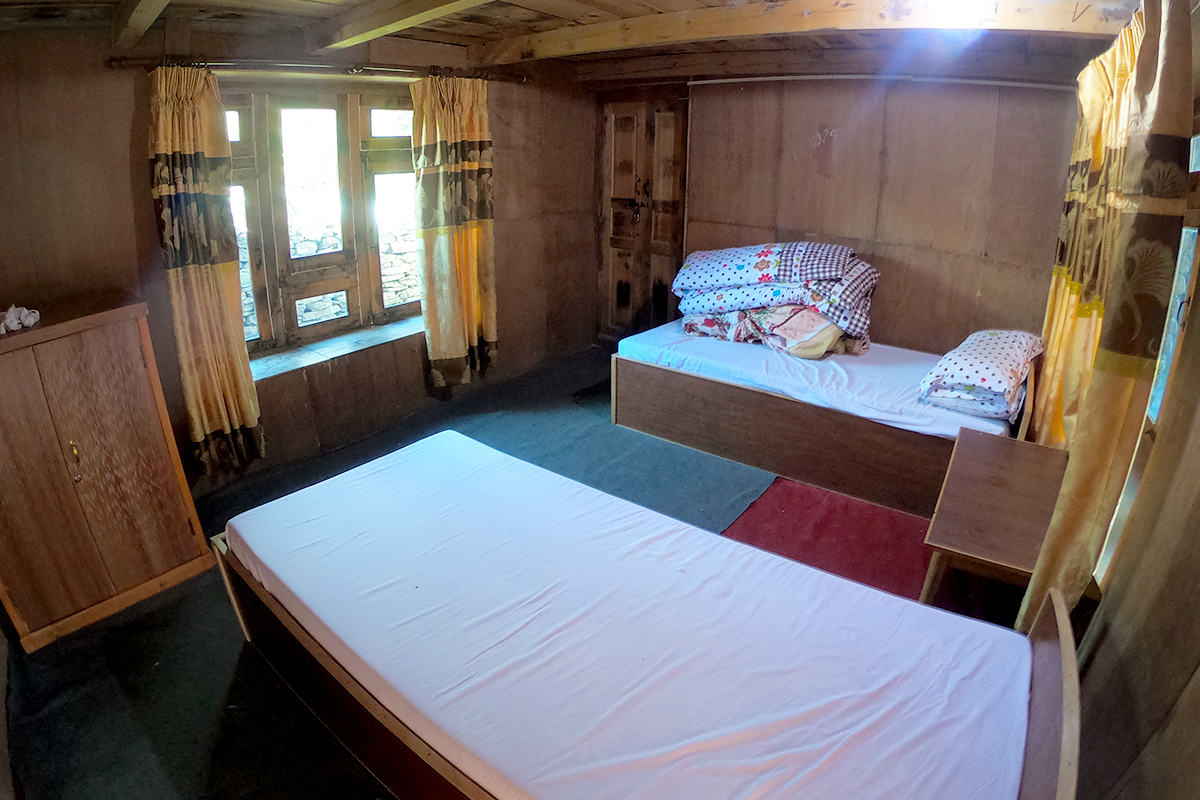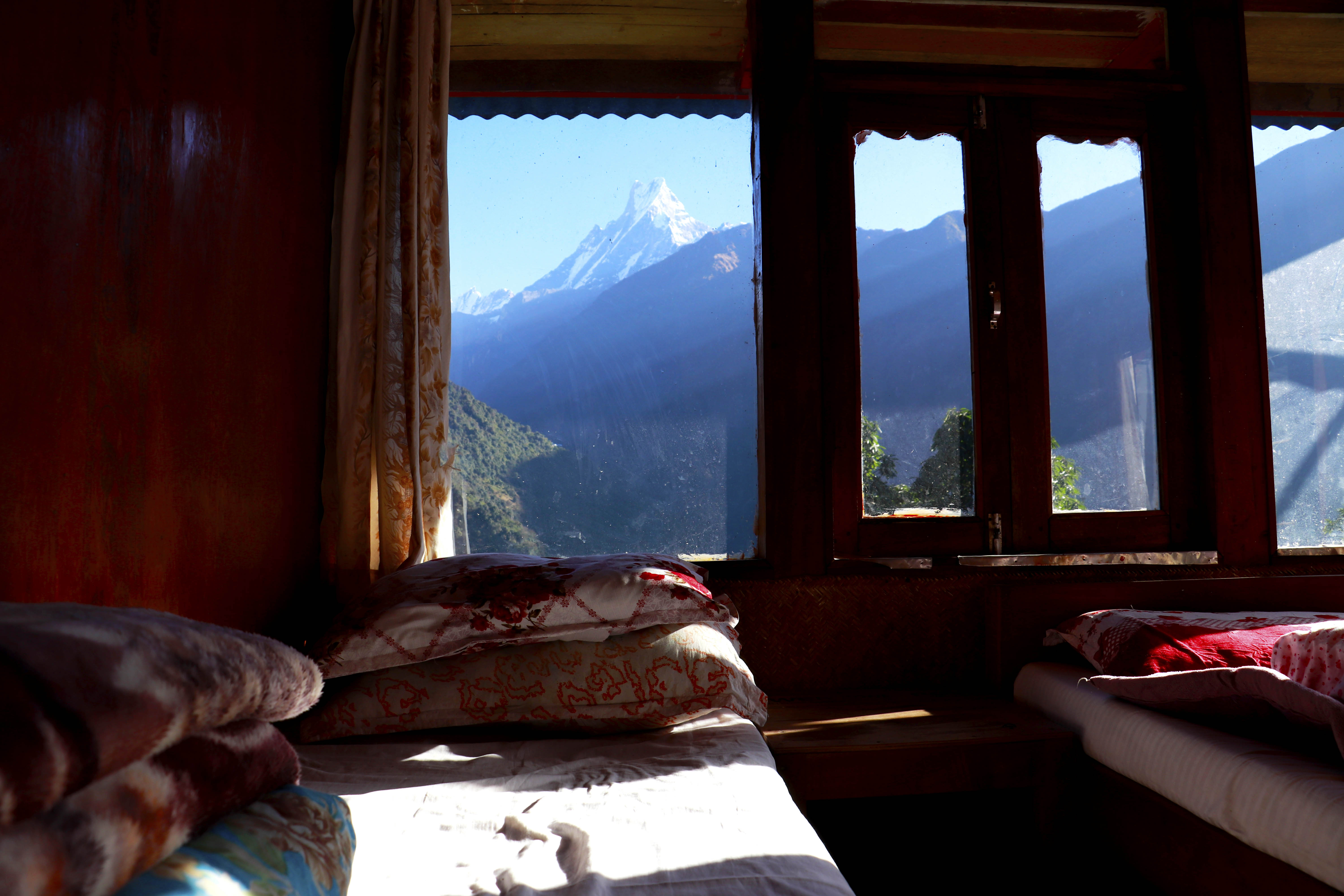Annapurna base camp trek accommodation is important to ensure your enjoyable and comfortable trip. Upon embarking on this popular trail, you can find numerous simple, home-style teahouses, cozy lodges, and a few more comfortable hotels. Each accommodation class differs in warmth, comfort, and facilities that will make all the difference in your overall experience, especially when the trek starts to get challenging. A good night's sleep in a friendly spot refreshes you for the next day's hike and lets you experience Nepal's mountain villages with their beautiful views and friendly locals.
Table of Content
Why Choosing the Right Accommodation Matters for Your Annapurna Trek Experience

- Rest and Recovery: After long days of hiking, a comfortable place to sleep is important for recovery. It keeps you fresh and ready for the next leg of your journey.
- Health and Safety: More decent accommodations offer cleaner rooms, better sanitation, and safer facilities, which are relevant in remote areas.
- Comfort in Challenging Weather: Some offered warmth, hot showers, and cozy common rooms—essentials during cold mountainous treks.
- Local Experience: Staying in Annapurna base camp tea houses allows guests to be exposed to Nepali culture, interact with the locals, and taste real Nepalese food, which adds to the depth of the trek.
- Scenic Views: Most Annapurna base camp hotels and teahouses were strategically positioned to offer a great view of the Annapurna and Machapuchare mountains, making your ABC trek accommodation as memorable as your trek.
- Availability and Flexibility: Planning your ABC trek accommodation ahead of time ensures you are not spending a night searching for a room during peak months in an overcrowded spot.
- Budget Planning: Knowing what accommodations exist along the route aids in meal planning, hot showers, and other extras.
Types of Accommodation Available Along the Trek
1. Teahouses and Lodges
/tea house (1).jpg)
The most common accommodations along the trek are teahouses. These family-run, locally-owned places are simple yet friendly and offer cultural experiences in Nepal. The rooms of teahouses used for accommodation are usually very basic, containing two single beds, a table, and shared bathrooms. Though without luxuries, teahouses are friendly; they offer home-cooked meals, and meeting and interacting with other trekkers is highly admirable.
2. Luxury Lodges
If you're looking for extra comfort, sections of this trek have luxury lodges. These trek resorts boast larger rooms, including private bathrooms, hot showers, and Wi-Fi from time to time. Most of the time, you will enjoy splendid mountain scenery right from your window; these are ideal lodges for trekkers who like the trek but not at the expense of comfort. They are also ideal for people who see the importance of privacy and comfort after a long day.
3. Camping
Those who want to feel the place's wildness can camp along the route. This involves more preparation and equipment, but camping means sleeping under the stars and completely with nature. A tent can be pitched at any specified camping spot along the route. This is a perfect option for adventure seekers who need solitude and flexibility, especially when trekking with a group or during the off-season.
Each accommodation type available along the trek offers something unique, from a cultural experience in Annapurna base camp tea houses to comfort in luxury lodges and a raw, back-to-nature feel in camping. Knowing your options will help you find the right balance of comfort and adventure for your trek.
Tips For Trekking To Annapurna Base Camp
Top Recommended Teahouses and Lodges on the Route
Best Places to Stay for Mountain Views
Some of the teahouses and lodges stand out for their incredible views. They would be ideal for trekkers wanting to immerse themselves in the beauty of the Himalayas. You get to wake up and retire to bed with great mountain panoramas.
- Panorama Guest House, Chomrong: It has a great view of the Annapurna range and is good for viewing the sunrise and sunset.
- Machhapuchhre Guest House, Machhapuchhre Base Camp: Situated near the base camp, this teahouse provides direct views of both Machhapuchhre and Annapurna.
- Himalaya Hotel, Deurali: This hotel is renowned for its high altitude and outstanding views of surrounding peaks.
- Fishtail Lodge, Bamboo: It has beautiful valley and mountain views, adding beauty to your stay.
- Annapurna View Lodge, Chomrong: As the name suggests, this is one of the best viewpoints for viewing Annapurna and other nearby peaks.
Recommendation Read: Best Seasons for Annapurna Base camp Trek
Best Places for Warm Hospitality and Cultural Immersion
Teahouses along the trek are family-run businesses, providing the only opportunity to experience Nepali hospitality firsthand. Such places are famous for their friendly hosts, and thus, this is an immersive cultural experience with local stories over traditional meals.
- Green View Guest House, Sinuwa: This teahouse is famous for its friendly hosts. It offers warm accommodation and traditional Nepali meals.
- Machhapuchhre Guest House, Machhapuchhre Base Camp: The Hosts here are reputed for their hospitality and knowledge of local cultures.
- Everest Lodge, Jhinu Danda: Famed for the nearby hot springs and warm-hearted hosts who treat the trekkers like one of their homes.
- Hilltop Teahouse, Ghandruk: Homely environment with delicious food and friendly local reception.
- Peaceful Lodge, Tadapani: The name suggests an undisturbed stay filled with tremendous local hospitality and cultural interaction.
Hidden Gems: Underrated Lodges with Excellent Amenities
These lesser-known lodges often have reasonable rates, offer good amenities, and a more subdued atmosphere; hence, these are the hidden treasures along the path.
- Mountain View Lodge, Dovan: This lodge provides small but comfortable rooms, spectacular views down the valleys, and a low population.
- Snowland Lodge, Himalaya: A less famous site, but it is clean and quiet.
- Eco Village Lodge, Deurali: It is an ecologically friendly lodge, so to speak, and tranquil, with better facilities than expected.
- Forest Camp Lodge, Bamboo: quiet, out of the way, pretty surroundings, good service.
- Hidden Paradise Lodge, Sinuwa: excellent facilities quieter than other noisy places on the trek.
Tea Houses In Everest Base Camp trek
What to Expect from Teahouse Amenities

Teahouses on the trek route to ABC cater to quite a practical experience for trekkers. While the facilities vary from place to place, there's generally an outlook that you will get at most teahouses. The following provides some breakdowns of what you can expect whenever you stop at a teahouse during the ABC trek.
1. Basic Rooms and Bedding
- Teahouse rooms are always very basic but sufficient. Imagine a small room with two single beds, a table, and a small window.
- Bed linen consists of a mattress, a pillow, and a blanket. Bringing a sleeping bag to keep warm is a good idea, especially at higher altitudes and during colder periods.
2. Shared Bathrooms
- Most teahouses have shared bathrooms, usually very simple slope toilets. At higher elevations, there are fewer running water facilities; hence, you get a simple facility with a bucket shower or no shower.
- Some comfortable teahouses may have a Western-style toilet and a hot shower for an extra charge.
3. Electricity and Charging Options
- Most teahouses have electricity, but it's limited and often only available at certain hours of the day, typically in the evening when trekkers have returned from their hike.
- There is usually a minor charge for charging your phone or camera.
- Charging is by solar power or small generators, so it will be slower than you are used to at home.
4. Wi-Fi/Communication
- Wi-Fi is available in some teahouses but must be relied upon only sometimes, especially in remote areas.
- It would be advisable to manage your expectations concerning internet connectivity.
- Most teahouses usually have a local or satellite phone for emergency use, but you must pay for the calls.
5. Meals and Drinks
- Teahouses serve filling local dishes such as dal bhat, noodle soup, momos, and many snacks. For Westerners, there is pasta, sandwiches, and omelets.
- Drinks start from tea, coffee, and hot chocolate to cold drinks. However, cold drinks can be quite expensive higher up.
6. Heating and Hot Water
- Although many teahouses have rooms without heating, the common areas often have a stove or a heater to keep them warm. This becomes more vital during the cold months when temperatures drop.
- Hot water for drinking or washing is usually available at most teahouses; you must pay a small amount to get it in most places.
7. Atmosphere and Social Interaction
- Teahouses are usually lively, friendly places where trekkers can meet other hikers from all over the world. They're also a place to interact with locals working there and hear a little about the culture.
- You can expect a friendly, family-like atmosphere in these places. The trekkers and the staff often share tea or coffee in the common areas.
8. Extra Amenities
- Some teahouses offer extra facilities such as a small shop for trekking gear, laundry services that could be charged extra, and even a cozy area with a fireplace to relax after a long day of trekking.
- Depending on the altitude, some teahouses may have limited Wi-Fi, charging stations, or even local entertainment in the form of music or stories the locals share.
- While teahouses along the trek may not be fancy, they can still provide a basic level of comfort to trekkers, a warm environment, and a chance to experience local culture in a quiet mountain setting.
Tips for Booking Your Accommodation
Booking Ahead vs. On-the-Spot Reservations
In peak trekking seasons, such as spring (March to May) and autumn (September to November), the ABC trail fills up quickly, particularly at popular stops like Chomrong, Bamboo, and Deurali. In these months, booking in advance is necessary so you're guaranteed a place to stay and can concentrate on the trek rather than finding lodging at the last minute.
If a bit of comfort is wanted, such as with the luxury lodges found in villages down lower, reservations way in advance are quite necessary since there are few and often fill up even faster. It's more flexible during the off-season, and often, accommodation can be booked on the spot.
Recommendation Read: Complete Guidebook for Annapurna Base Camp Trek
Budgeting for Accommodation Costs on the Annapurna Trek
- Accommodations on the ABC trek vary from basic teahouses to comfort-offering Annapurna base camp hotels and are all-inclusive.
- Basic teahouse rooms often cost very little, say 5 to 10 dollars per night, making the trek quite accessible for modest budgets.
- Upscale accommodations that offer extra amenities along the route, such as a private bathroom, heat, or a view, also cost between $50 and $150 per night.
- Regarding budgeting, you include daily meal costs, as most teahouses offer meal packages with different price brackets.
- Extra amenities, like hot showers or charging devices, may also be offered in some places for small additional fees that add up for the trek.
Read our Blog, Packing List For Annapurna Base Camp trek
Handling High-Season Crowds and Avoiding Overbooked Teahouses
ABC is an extremely popular trek, and numerous people are on the trail during peak seasons. This sometimes ensues in teahouses that are fully booked en route. The best way to beat this madness is to leave your campsite early in the morning and head toward your next destination. The other useful advice is to consider staying in villages that are somewhat off the main stops, as these villages can also provide similar amenities but with less crowding.
Some trekkers enjoy consulting with their guide, as the guides can provide information regarding lesser-known teahouses in nearby villages that can still offer comfort and quality. If you plan strategically, you can avoid all the overbooked spots and have a comfortable and memorable trek.
Featured Trip: Annapurna Base Camp Short Trek
Conclusion
Accommodation options vary on the Annapurna Base Camp Trek, making one's journey more memorable. From very affordable teahouses to comfortable lodges, each has a special way of making your stay unique and special by letting you blend into stunning landscapes and warm-hearted locals. This may serve as a guide while planning, considering the seasonal demands, and booking in advance if necessary to ensure comfort and stress-free trekking.
FAQs
Where do you sleep in Annapurna Base Camp?
Teahouses, lodges, and guesthouses are some basic accommodations along the ABC trek. The meals are average, too. The rooms range from shared to private, with some areas offering more comfort. After a day's hike, these cozy stays offer warmth and a welcoming resting place.
How many days do you need for the Annapurna Base Camp trek?
Most trekkers complete this journey in 7-12 days, depending upon their starting point, fitness level, and need for acclimatization. This duration allows for a comfortable pace that includes adequate rest days. With a relaxed schedule, they can fully enjoy the scenery and culture along the way.
Which is the highest point of the Annapurna Base Camp trek?
The highest of ABC is 4,130 meters or 13,550 feet. Trekkers can now see great views of various peaks, including Annapurna I and Machhapuchhre. This is a highlight of the trek, marking the endpoint of this journey and one of the more remarkable vantage points.
How much does it cost to hike Annapurna Base Camp?
The cost of the trek ranges from $400 to $800, including permits, accommodation, and food provided along the way. Other expenses include hot showers, equipment hire, and guides, if desired. Proper budgeting leaves room for comfort without any unexpected expenses.
Is the ABC trek suitable for beginners?
Yes, it's suitable for beginners with reasonable fitness and some preparation. The trail has a gradual elevation gain and moderate difficulty, hence being relatively accessible. With proper pacing and acclimatization, a beginner can be comfortable enjoying the richness of this trek in scenic and cultural aspects.
What’s the best time of year to trek to Annapurna Base Camp?
Spring starts in March and lasts into May, and autumn occurs between September and November. Both offer clear skies, stable temperatures, and tremendous views. Indeed, these seasons have the most favorable weather conditions. Trekkers get to see vibrant landscapes with uninterrupted mountain vistas during these months.


